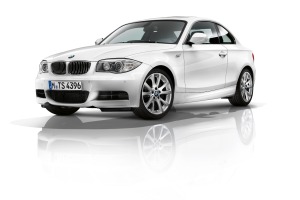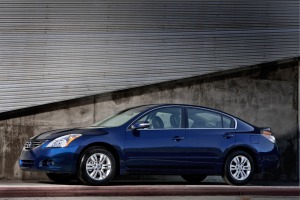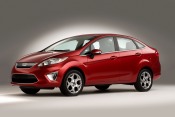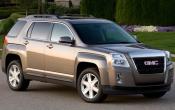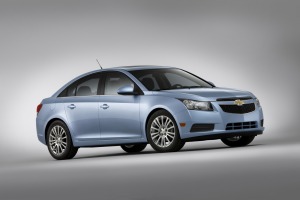
Less than a year ago, the total number of gasoline-powered cars in the U.S. that could achieve 40 miles per gallon or more on the highway was exactly one: the 2010 Smart Fortwo.
But the 40 mpg club is getting a whole lot bigger in the U.S. And it's just in time. Gasoline is regularly topping $4 per gallon in parts of California, Maine and New York. Numerous analysts are forecasting $5-per-gallon gas later this year.
Here's a detailed look at the 2011 and 2012 model-year members of the gas-powered 40 mpg highway club, including some insights into the way they achieve extreme efficiency without resorting to diesel fuel, hybrid technology or electric power. Keep in mind that these are variants or special packages found on more mainstream models. If you're shopping, make sure you zero in on the super-saver versions.
2011 Chevy Cruze Eco
The 2011 Chevy Cruze Eco arrived in dealerships in January with some very attractive numbers: an MSRP of $18,175 and EPA-estimated fuel economy of 42 mpg highway and 28 mpg city (manual transmission model only). That price is $2,000 more than the base Chevy Cruze.
General Motors attributes some of the Cruze Eco's fuel efficiency to aerodynamic improvements derived from more than 500 hours of wind-tunnel testing of the Chevy Volt, which shares the same platform and bodywork. Examples include the upper grille, which has been closed off in many places to reduce drag, plus an extension for the front airdam, a rear spoiler, underbody panels that smooth airflow beneath the car, and a lower ride height. The Eco also has a shutter behind the lower part of the grille that closes at high speed to reduce aerodynamic drag and opens at low speed to optimize engine-cooling airflow.
GM says these and related enhancements reduce aerodynamic drag by 10 percent over a non-Eco Cruze, producing a coefficient of drag (Cd) of 0.298. The average modern automobile achieves a drag coefficient of between 0.30 and 0.35. Typically, only high-performance sports cars and highly fuel-efficient vehicles have a coefficient of drag less than 0.30.
The Chevy Cruze Eco is also relatively light at 3,009 pounds, an impressive 214 pounds less than a conventional Cruze 1LT. Simply reducing the size of the flanges for the bodywork by 1-2 mm trimmed several pounds. The engineers also shaved the thickness of sheet metal by about 0.1 millimeter in select components. In addition, each lightweight, cast-aluminum 17-inch wheel with its Goodyear low-rolling-resistance tire weighs only 36.5 pounds, 5.3 pounds less than the 16-inch wheel-and-tire combination of the Cruze 1LT for a complete savings of 21.2 pounds.
The final piece of the Cruze Eco combination is the turbocharged 138-horsepower 1.4-liter engine with a six-speed manual transmission. It has an especially tall overdrive ratio for 6th gear that reduces engine rpm at cruising speed for better fuel economy.
2011 Ford Fiesta SE SFE
SFE stands for "super fuel economy," which is a package of fuel-conserving measures that allow this variant of the 2011 Ford Fiesta subcompact to achieve an EPA rating of 29 mpg city and 40 mpg highway. The SFE package is a $695 option for the $14,320 Fiesta SE sedan and a $395 option on the $15,120 Fiesta SE hatchback.
The SFE package includes aerodynamic enhancements that include blocked portions of the lower grille, underbody panels (both of which reduce aerodynamic drag), lightweight cast-aluminum wheels with low-rolling-resistance tires, and a six-speed automated manual transmission.
There doesn't seem to be much of a secret to the Fiesta's fuel efficiency: It's a lightweight car with a small 1.6-liter engine that makes just 120 hp. Its significance comes from the inclusion of an automatic transmission, which will help make the car appeal to a larger audience. Only 10 percent of Americans prefer a manual transmission.
An automated manual transmission shifts automatically like the automatic transmissions that you're used to, but it has the same dry-type clutches that give a manual transmission better efficiency. It is lightweight compared to a conventional automatic, offers an optimal number of ratios to maximize engine efficiency and works relatively seamlessly so it won't distract you.
The Fiesta also features electrically assisted steering, a measure that improves efficiency over pure hydraulic assist by reducing mechanical friction, yet nevertheless delivers the speed-sensitive power assist that drivers expect from modern automobiles. By 2013, Ford will use this technology in nearly 90 percent of its lineup.
2012 Ford Focus SFE
Late last month, Ford announced that its 2012 Focus sedan with its optional SFE package had received an EPA fuel economy estimate of 40 mpg highway.
Just as before, the Focus uses a 2.0-liter inline-4 engine, but now this engine features high-pressure direct fuel injection. This technology improves the atomization of fuel in the cylinders, effectively reducing fuel use with no loss in power. Meanwhile, the use of variable valve timing on both the intake and exhaust side of the engine broadens the available spread of power across the rpm range, increasing usability. This revised engine delivers more power than the engine it replaces while contributing to an overall fuel economy gain of 10 percent.
And as with the 2011 Ford Fiesta, the new Focus uses an automated manual transmission, offering the efficiency you expect from a manual transmission with the convenience of automated shifting that you expect from a conventional automatic. Ford says its PowerShift six-speed transmission can help to reduce fuel consumption by up to 9 percent compared to a traditional four-speed automatic.
The SFE package includes fully active shutters behind the front grille to help optimize aerodynamics. If air is required to cool the engine, the vents open. If no airflow is needed, the vents close, significantly reducing aerodynamic drag. Automatically controlled by the car's electronic control unit, the vanes can be rotated into 15 different positions depending on the amount of cooling air required.
When the vents are fully closed, the reduction in aerodynamic drag effectively produces a 2 percent improvement in CO2 emissions, Ford says. As an additional benefit, the vanes stay closed when the engine starts up, helping the engine to reach its most efficient operating temperature more quickly, thereby reducing fuel consumption.
Once you add the SFE package's low-rolling-resistance tires, all these incremental improvements in fuel efficiency help the 2012 Ford Focus crack the 40 mpg barrier on the highway. The SFE package is a $495 option on the 2012 Focus SE Sedan, which starts at $17,270.
2012 Honda Civic HF
In February Honda announced that the forthcoming 2012 Honda Civic will include a model dedicated to fuel efficiency called the Civic HF ("HF" stands for high fuel economy).
The HF is equipped with a 1.8-liter i-VTEC inline-4 engine generating a respectable 140 hp and aims to earn an EPA fuel economy estimate of 41 mpg highway. The Civic HF will be equipped with a five-speed automatic transmission and a special package of components to improve aerodynamics.
It will also feature Eco Assist, a Honda technology designed to help drivers develop and maintain a fuel-efficient driving style by using dashboard visual aids to tell them they are driving efficiently — and when they aren't. (Presumably this is a step beyond the shift lights that became a staple when fuel efficiency last came into fashion.) Pricing hadn't been announced as of this article's publication date.
2011 Hyundai Elantra
The refreshingly sporty-looking 2011 Hyundai Elantra compact offers economy two ways — a miserly base price of just $14,830 and an EPA fuel-efficiency rating of 29 mpg city and 40 mpg highway.
Hyundai America has made the 29 city/40 highway mpg fuel economy rating standard across the Elantra line while keeping the car's cost below $15K. Both the Ford Fiesta SE SFE and the Chevrolet Cruze Eco offer outstanding fuel economy, but they are special fuel economy editions and as such carry a price premium over the base models.
The Elantra comes standard with a 148-hp 1.8-liter inline-4 engine, which is knocked down to 145 hp for a partial zero-emissions-vehicle (PZEV) model that will be sold in California, Oregon and several states in the Northeast.
There's a six-speed manual in the base GLS model and a six-speed automatic in the higher-trim Limited model. Hyundai credits the widespread use of lightweight steel for the Elantra's 2,660 pounds, which makes it one of the lightest compacts on the market. This contributes to good fuel economy, but it also helps give the Elantra the best horsepower-to-weight ratio in the compact segment, so it's the liveliest model in the compact class.
At the same time, the Elantra's engine is the single most significant contributor to the new car's fuel-sipping ways. For one, this all-aluminum engine weighs substantially less than the iron-block engine it replaces. Next, the combination of a two-step variable-length intake manifold and continuously variable intake and exhaust cams help broaden the power curve while improving fuel economy. A high-tech alternator only charges when it is most efficient to do so, improving fuel economy by reducing mechanical friction.
2011 Smart Fortwo
The Smart Fortwo achieves 33 city/41 highway mpg, and it was the only member of the 40 mpg club for some time. But because it is a two-passenger city car, its fuel efficiency has been largely ignored, simply because it looks so different. The Fortwo's pricing begins at $12,490 for the coupe. You can step up to a more sporting trim level at $14,690 and a cabriolet priced at $17,690.
Just like the other members of the 40 mpg club, the Smart Fortwo is all about a lightweight package with a fuel-efficient engine. The controversy about the car comes because its 70-hp 1.0-liter three-cylinder engine seems far from conventional, even though the Fortwo is surprisingly energetic around town. It is not necessarily a freeway car, however, and Americans are uneasy with anything other than a freeway flyer.
The engine's perceived liabilities also begin to stack up because it requires premium fuel, which makes sticker shock at the pump even stronger. And then there's the automated manual transmission, a single-clutch design that shifts slowly and relatively clumsily.
Because Mercedes-Benz builds the Smart Fortwo, the city car has a full allotment of safety technology, including a stout passenger cell of high-strength steel, front airbags, side curtain airbags for the coupe models and side airbags for the cabriolet, knee bolster airbags, antilock brakes, hill-hold assist, stability control and traction control.
That said, you'll notice that the 40 mpg club is about the EPA's highway rating, and the city-oriented Smart Fortwo's size seems unsuited to the mix of vehicles on American freeways, so the car's fuel economy goes unappreciated.








